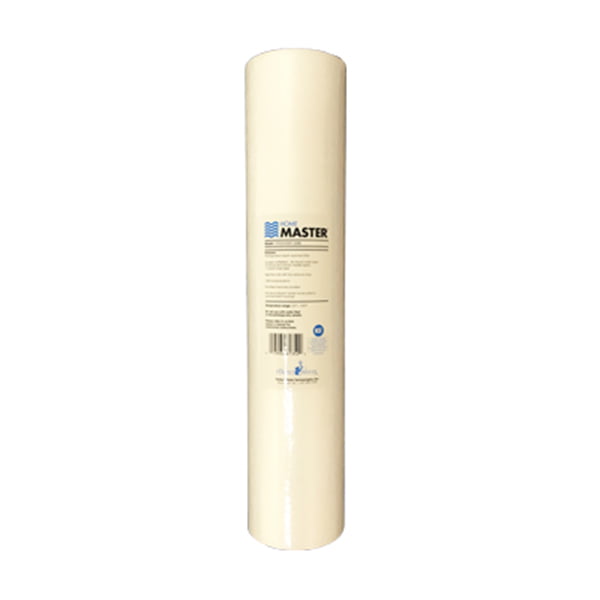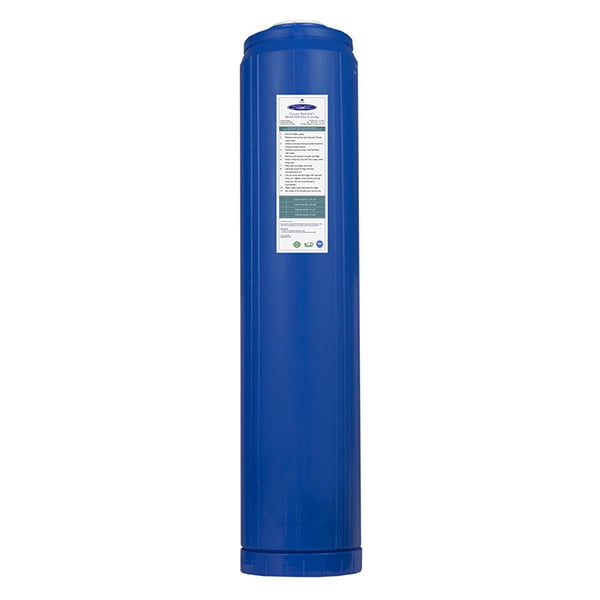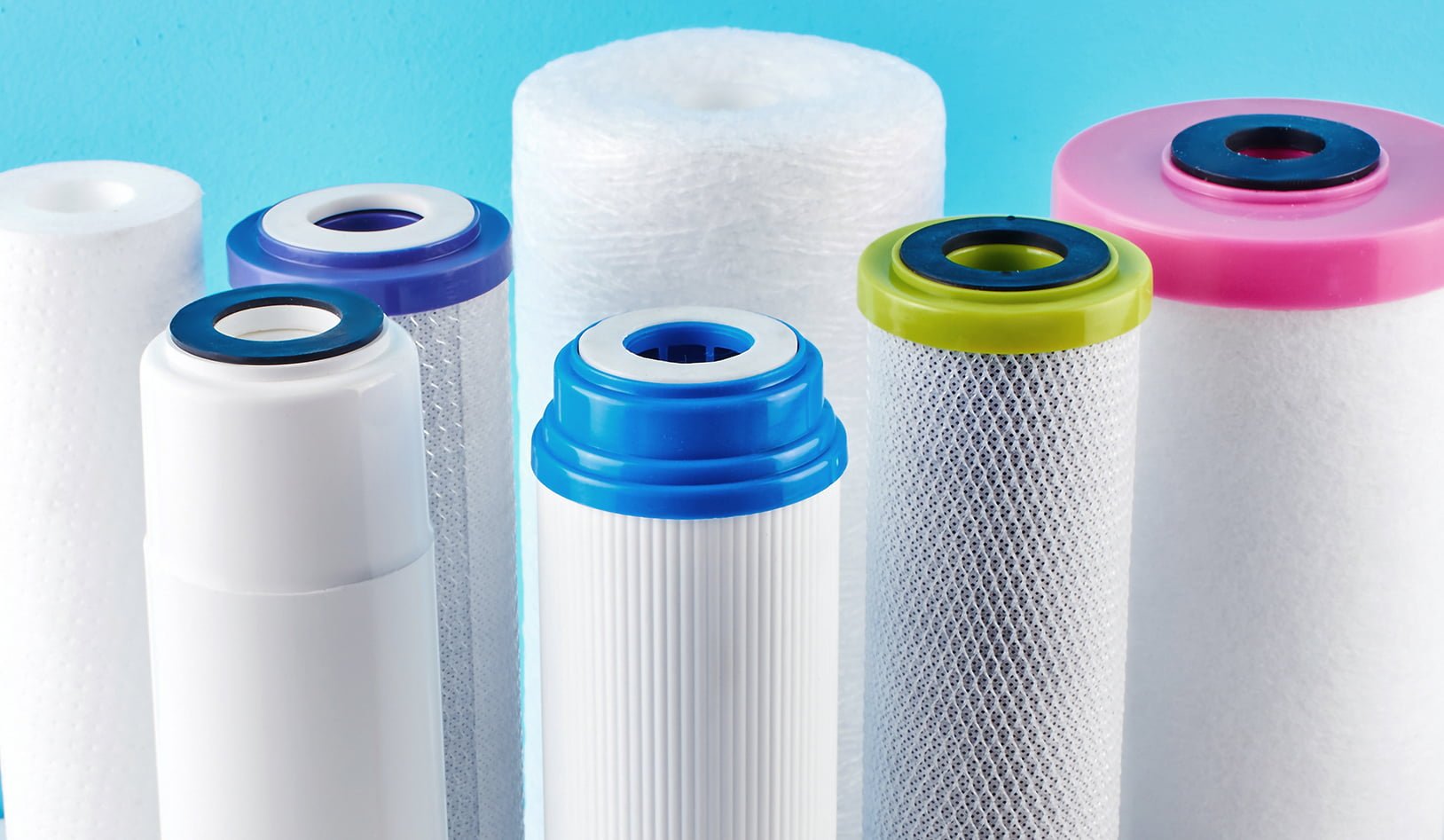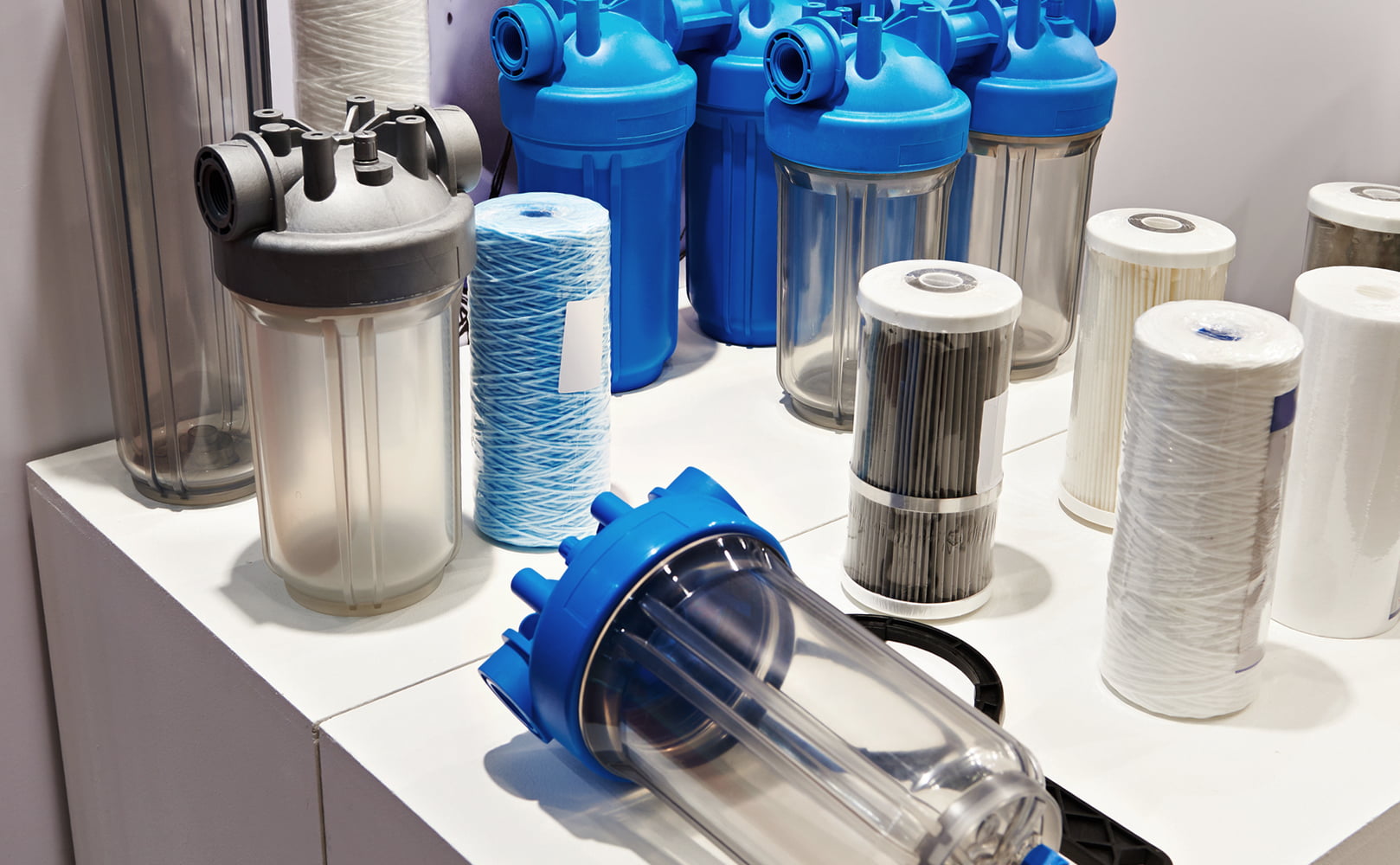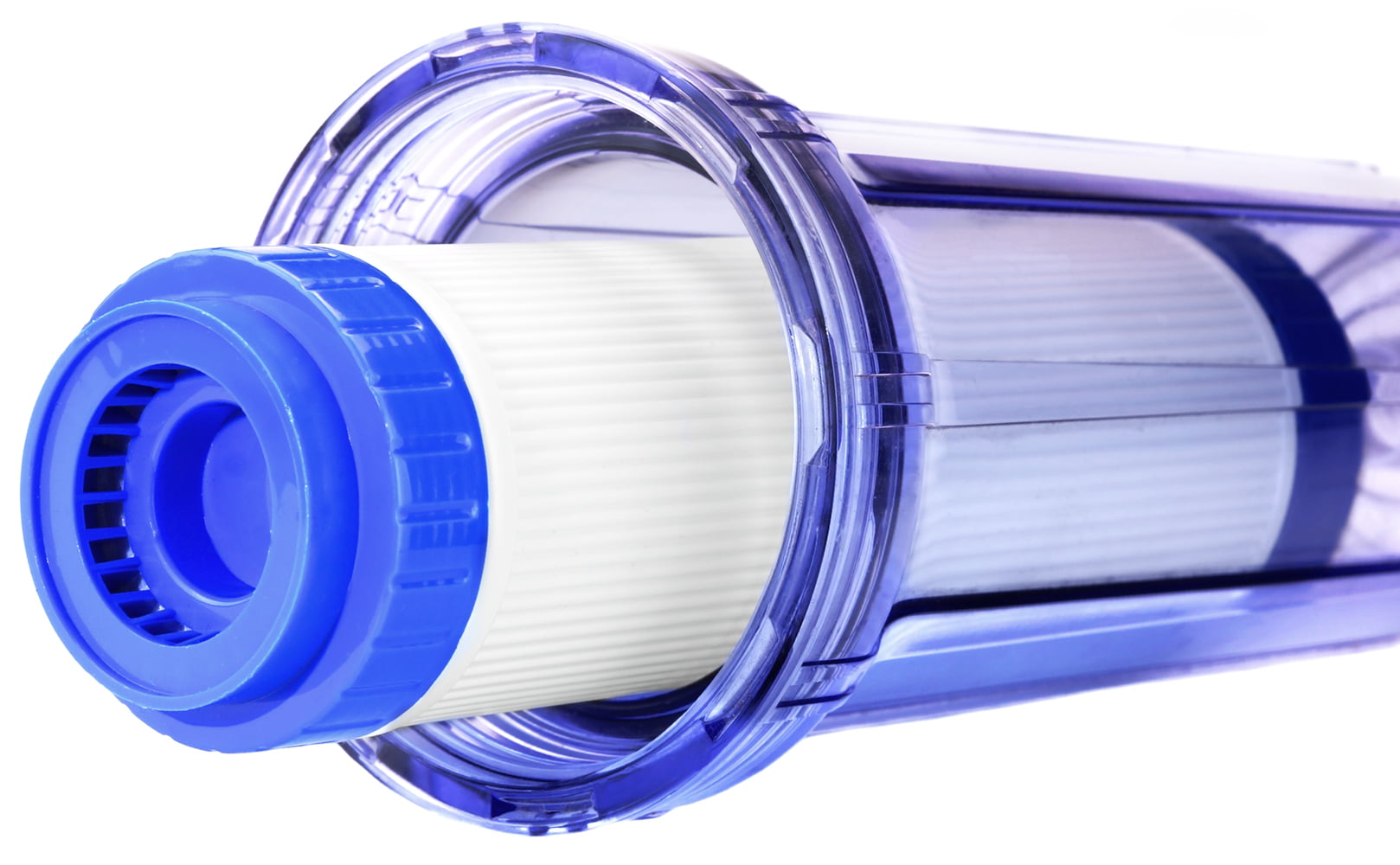9 Best Whole House Water Filter Cartridges (*Update 2024)
Written by: Gene Fitzgerald // Expert Fact-Checking: Buddhini Dolapihilla, MBSS // Last Updated: Jan 31, 2024
This page may contain affiliate links. If you buy a product or service through such a link we earn a commission at no extra cost to you. Learn more.
Top Pick: What’s the Best Whole House Water Filter Cartridge?
The best whole house water filter cartridge in 2024 is the Crystal Quest SMART Plus, because it targets all types of water contaminants, has a long filter life of up to 1.5 years, and is made in the USA, standard-sized, and pretty affordable.
There are not only hundreds of different whole house water filter cartridges, they also come in different sizes – standard-sized and proprietary. Needless to say, choosing the one cartridge that’s ideal for your water supply can be difficult.
To help you with that, we’ve evaluated 27+ of the most popular whole house water filter cartridges on the market since the first edition of this buying guide was published on December 14, 2021. In other words, we’ve spent dozens of hours researching, reviewing, and testing products in order to provide as much value as possible and keep this guide accurate and up to date. Hopefully, you find it useful…
No Time to Read? Check Our List of the Best Whole House Water Filter Cartridges!
| Cartridges | Details | |
|---|---|---|
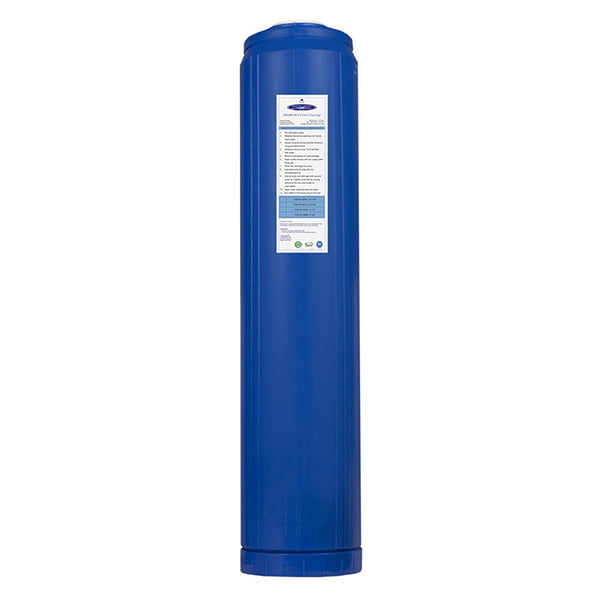 Best for All Contaminant Types: Crystal Quest SMART Plus |
Overall Rating: 5.0/5.0 ⓘRatings based on contaminant reduction, filter life, water flow rates, costs, our testing, 3rd-party opinions, product support and warranty, and other factors.
Get 5% Off! Use Code: |
Price: $$ Type: Mix of Filter Media Cartridge Life: 80,000-160,000 gal Water: 3-6 Gallons Per Minute Annually: ~$105-240 Read Review: Click |
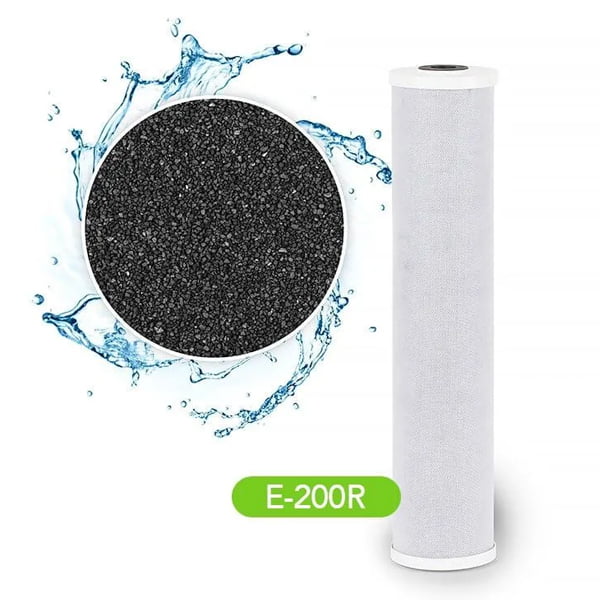 Best for Organics + Bad Taste & Odor: Kind E-200R |
Overall Rating: 5.0/5.0 ⓘRatings based on contaminant reduction, filter life, water flow rates, costs, our testing, 3rd-party opinions, product support and warranty, and other factors.
Get 5% Off! Use Code: |
Price: $ Type: Catalytic Carbon Block Cartridge Life: 12 Months Water: 15 Gallons Per Minute Annually: ~$130 Read Review: Click |
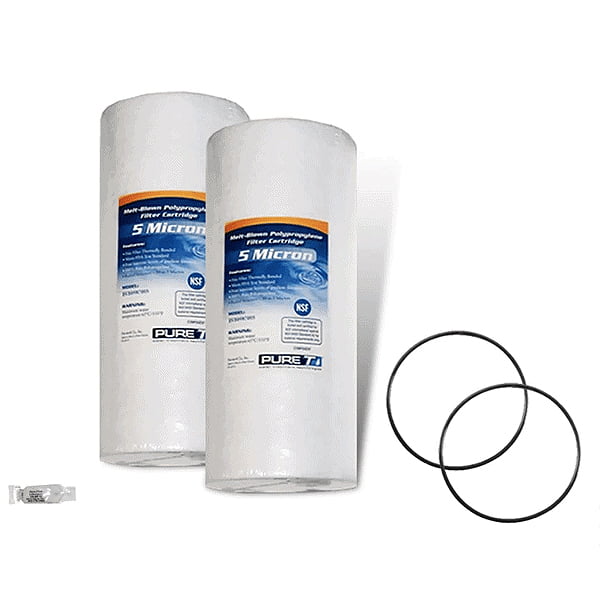 Best for Sediments: PureT 5-Micron Sediment Filter Cartridge |
Overall Rating: 5.0/5.0 ⓘRatings based on contaminant reduction, filter life, water flow rates, costs, our testing, 3rd-party opinions, product support and warranty, and other factors.
Get 5% Off! Use Code: |
Price: $ Type: Sediment Filter Cartridge Life: 6-9 Months Water: 20-35 Gallons Per Minute Annually: ~$40 Read Review: Click |
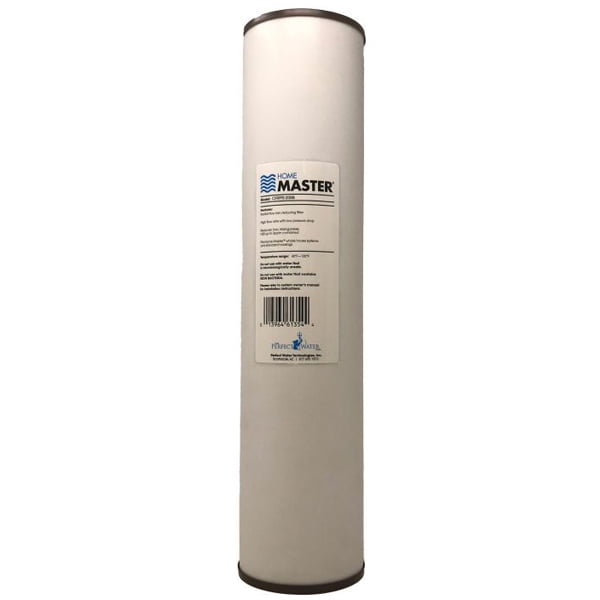 Best for Iron: Home Master Iron Filter Cartridge |
Overall Rating: 4.5/5.0 ⓘRatings based on contaminant reduction, filter life, water flow rates, costs, our testing, 3rd-party opinions, product support and warranty, and other factors.
|
Price: $ Type: Greensand Cartridge Life: 26,000 gal at 3 ppm Iron Water: ? Annually: Varies Read Review: Click |
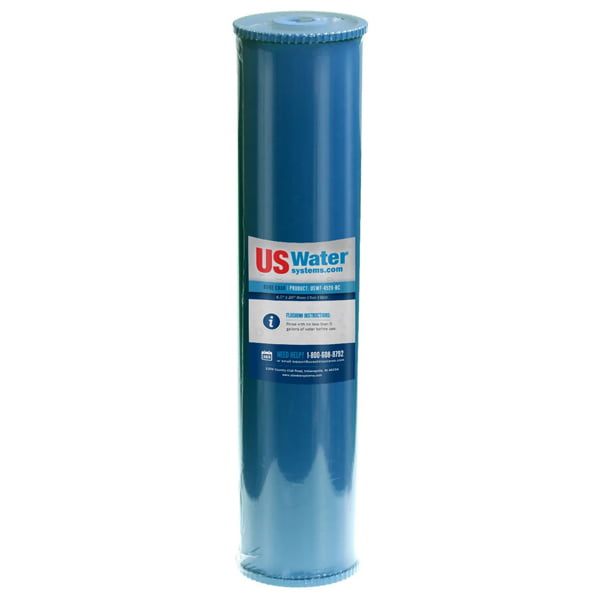 Best for Fluoride: US Water 507-USWF-4520-BC |
Overall Rating: 4.0/5.0 ⓘRatings based on contaminant reduction, filter life, water flow rates, costs, our testing, 3rd-party opinions, product support and warranty, and other factors.
Get 5% Off! Use Code: |
Price: $$$ Type: Aluminum Oxide Cartridge Life: 2,500 gal at 1 ppm Fluoride Water: 4 gpm Annually: Varies Read Review: Click |
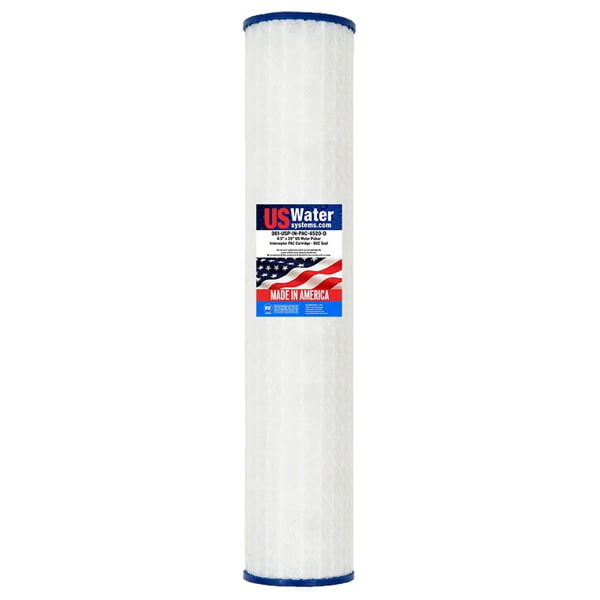 Best for Lead: US Water Interceptor |
Overall Rating: 4.5/5.0 ⓘRatings based on contaminant reduction, filter life, water flow rates, costs, our testing, 3rd-party opinions, product support and warranty, and other factors.
Get 5% Off! Use Code: |
Price: $$ Type: Submicron, PAC, Agion Silver Cartridge Life: 12 Months Water: Not Specified Annually: ~$200 Read Review: Click |
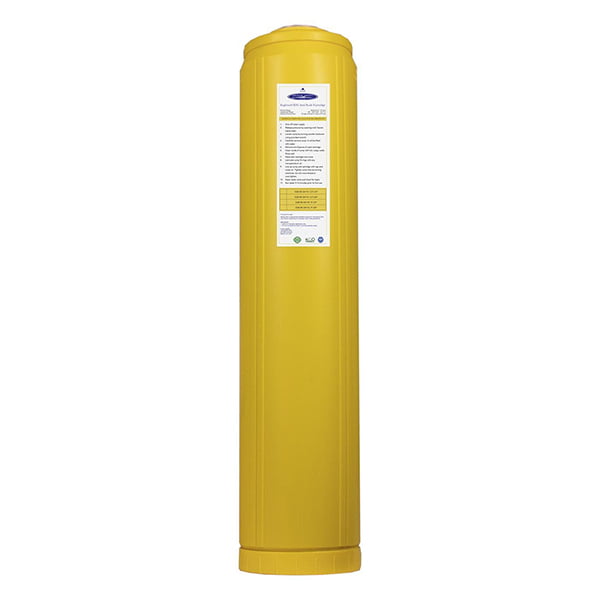 Best Anti-Scale: CQ Eaglesorb ES3 Whole House Water Filter Cartridge |
Overall Rating: 3.5/5.0 ⓘRatings based on contaminant reduction, filter life, water flow rates, costs, our testing, 3rd-party opinions, product support and warranty, and other factors.
Get 5% Off! Use Code: |
Price: $$$ Type: Anti-Scale Media Cartridge Life: 2,080-5,200 Hardness Grains Water: 3-6 gpm Annually: Varies Read Review: Click |
Whole House Water Filter Cartridge Reviews
Our Top Picks
- Crystal Quest SMART Plus – Best All Rounder
- Kind E200-R – Best for Organics and Improving Water Aesthetics
- PureT Filter Cartridge – Best for Removing Sediments
- Home Master Multi-Gradient Density Cartridge – Runner-Up for Sediment
- Crystal Quest GAC Filter Cartridge – Best for Improving Water Aesthetics
- Home Master Iron Filter Cartridge – Best for Iron
- US Water 507-USWF-4520-BC – Best for Fluoride
- US Water Interceptor – Best for Lead
- CQ Eaglesorb ES3 – Best for Limescale
1. Best All Rounder: Crystal Quest SMART Plus Whole House Water Filter Cartridge
In our opinion, the best whole house water filter cartridge in 2024 is the Crystal Quest SMART Plus. That’s because it combines several different filter media for very broad contaminant removal.
Meaning, it targets different kinds of contaminants including chemicals like pesticides and chlorine, lead and other heavy metals, sediment, and many more organic and inorganic substances. In addition, ceramic and tourmaline balls enhance the water to maintain a more alkaline pH.
Long story short: You get the complete package in a single filter cartridge. 5 stars!
Other Specs
- Model: CQE-RC-04027, CQE-RC-04030
- Last Price: $159.00-241.00
- Filter Media: GAC, Catalytic Carbon, KDF, Ion Exchange Resin, Ceramic Balls, Sediment Filter Pads
- Size: Standard-Sized (4.5×10 inches, 4.5×20 inches)
- Water Temperature: 40-145 °F
Key Features & Pros
- All Crystal Quest products are made in USA.
- We have 7 different types of filtration media:
- Granular activated carbon and catalytic carbon eliminate bad taste & odor and do the bulk of the chemical removal. They filter chlorine, chloramine, disinfection byproducts, pesticides, herbicides, and more.
- Eagle Redox Alloy 6500 and 9500 – commonly known as KDF – remove chlorine, hydrogen sulfide, and heavy metal content (lead, chromium 6, iron …). They also prevent microorganisms from accumulating in the filter.
- As the name suggests, the ion exchange resin reduces all kinds of poisonous ions/metals – think cadmium.
- Besides creating alkaline water, the ceramic balls have an antibacterial effect, they improve water aesthetics, and even absorb leftover heavy metals.
- Tourmaline balls support water absorption in your body as well as detoxification.
- Several micron filter pads are used to block sediments and other larger particles.
- At the end of the filter process you are left with great-tasting, healthy water.
- 2 different cartridge sizes to choose from:
- 4.5 x 20 inches (big blue) has a capacity of 160,000 gallons at 6 gallons per minute service water flow.
- 4.5 x 10 inches provides around 80,000 gallons of water at 3 gallons per minute.
- Please note: 2.5 x 20 and 2.5 x 10 are for point-of-use filters.
- Thanks to standard sizing the filter cartridges fit almost all filtration systems.
- The SMART Plus lasts about 12-18 months, depending on your water quality and usage. Annual cost: ~$105-240.
- You can subscribe to have new filter cartridges delivered on schedule and save 5%.
- Very large households should upgrade to the Ultra or Ultimate cartridge. They have higher filtration capacities.
- Great customer feedback. People are more than happy with the support in particular.
Cons
- One customer mentioned an aftertaste.
- Pricey, especially the ultra and ultimate versions.
- 3 to 6 gallons per minute water flow is not enough for homes with multiple bathrooms.
Our Rating
- Filtration Performance: 5.0/5.0
- Filter Capacity: 5.0/5.0
- Price: 4.0/5.0
- Annual Cost: 4.0/5.0
- Overall: 5.0/5.0
Best for
The Crystal Quest SMART Plus whole house water filter cartridge is best for broad contaminant removal.
2. Best for Removing Organics + Improving Water Taste & Smell: Kind E-200R
If your water supply is chock full of organic chemicals and you are dealing with aesthetic water issues, this whole house catalytic carbon block filter is just for you.
Catalytic carbon is like regular activated carbon on steroids. Chlorine, chloramine, pesticides, herbicides, industrial solvents, volatile organic compounds (VOCs), PFAS, MTBEs, and dozens of other chemical contaminants stand no chance. Neither does hydrogen sulfide and certain water-soluble heavy metals.
Want all the details?
Other Specs
- Model: E-200R
- Last Price: $131.15
- Size: Standard-Sized (4.5×20 inches)
Key Features & Pros
- This is the whole house filter cartridge to get if you want water without the slightest off-taste or bad smell.
- Cartridges contain a catalytic carbon filter block.
- The carbon reduces and removes all kinds of organics, bad taste and odor, and sulfur (rotten-egg smell).
- Catalytic carbon also helps with some heavy metals and radionuclides.
- Flow rate is 15 gallons per minute which is very high and ideal for larger homes.
- Universally compatible with standard-sized filter housings.
- Filter changes are easy.
- Manufacturer estimates filter life of 12 months. Costs are $130 annually.
- Subscribe to get 15% off.
- O-ring and lubricant included.
- Satisfaction guarantee.
Cons
- Don’t use this without a sediment pre-filter when on well water.
Our Rating
- Filtration Performance: 5.0/5.0
- Filter Capacity: 5.0/5.0
- Price: 4.5/5.0
- Annual Cost: 4.5/5.0
- Overall: 5.0/5.0
Best for
The Kind E-200R whole house water filter cartridge is best for removing organics from water while improving water taste and odor.
3. Best for Sediment: PureT 5-Micron Melt-Blown Polypropylene Filter Cartridge (via SpringWell)
Sediment filter cartridges are part of almost every water filtration and water softening system – for pre-treatment. If you need one, we recommend the melt-blown PP sediment cartridge by PureT (sold via SpringWell).
Why? Because of the 5-micron rating which guarantees removal of fine and coarse sand, silt, dust, and even some protozoan cysts and bacteria. And there’s more!
Other Specs
- Model: PureT 5-Micron
- Last Price: $40.18-$67.98
- Filter Media: 50-to-5-Micron Polypropylene
- Size: Standard-Sized (4.5×10 inches, 4.5×20 inches)
- NSF Certification: 42
Key Features & Pros
- The polypropylene media is designed for “general water filtration”. Any floating particles down to a size of 5 microns will be trapped.
- 4 different layers of gradient depth-filtration (50 to 5 microns) maximize dirt-holding capacity.
- There’s an NSF certification for structural integrity (standard 42).
- 2 different standardized filter sizes to choose from:
- 4.5 x 20 inches (big blue).
- 4.5 x 10 inches.
- Standard sizing means universally compatible with standard-size filter sumps.
- Exceptionally high flow rate of up to 20-35 gallons per minute.
- You get around 6-9 months of clean water out of every cartridge. Estimated annual replacement cost: $40.
- You can subscribe for a 5% discount.
- SpringWell is known for their excellent customer service. The staff is very knowledgeable, helpful, and patient. They will answer all your questions.
Cons
- Nothing so far.
Our Rating
- Filtration Performance: 5.0/5.0
- Filter Capacity: 5.0/5.0
- Price: 5.0/5.0
- Annual Cost: 5.0/5.0
- Overall: 5.0/5.0
Best for
The PureT 5-Micron is best for trapping sediments.
4. Sediment Filter Alternative: Home Master Multi-Gradient Density Cartridge
Another whole house sediment filter cartridge that we really like is this one sold by Home Master.
What’s special about it– this also goes for the SpringWell sediment filter cartridge reviewed right above – is the multi-gradient density structure for up to triple the dirt-holding capacity of similar sized filters. In other words: The cartridge lasts longer meaning less maintenance and lower cost due to fewer replacements required.
Other Specs
- Model: CFdgd2501-20BB
- Last Price: $35.95
- Filter Media: 25-to-1-Micron Polypropylene
- Size: Standard-Sized (4.5×20 inches)
- Water Pressure: 20-100 °F
- Water Temperature: 40-100 °F
- Water pH: 4-10
Key Features & Pros
- The filter cartridge reduces turbidity, sand, dirt, rust, and silt.
- Four separate filter layers boost dirt-holding capacity and prevent premature clogging.
- On the outside, the filter has a micron rating of 25 used to trap larger particles.
- A 10 and a 5-micron inner layer remove dust and silt.
- The 1-micron core layer filters what’s left, especially microorganisms like cysts and bacteria.
- Different micron ratings allow for high flow rates with only slight pressure drops.
- Material is chemical and bacterial-resistant.
- Standard 20 x 4.5-inch size fits big blue filter housings.
Cons
- Filtration capacity not specified.
Our Rating
- Filtration Performance: 5.0/5.0
- Filter Capacity: 4.5/5.0
- Price: 5.0/5.0
- Annual Cost: 5.0/5.0
- Overall: 5.0/5.0
Best for
The Home Master filter cartridge is our second top pick for filtering sediments and dirt.
5. Best for Regular Carbon Filtration: CQ Granular Activated Carbon Cartridge
Granular carbon is much more common than carbon blocks. And activated carbon is much more common than catalytic.
Other important benefits of granular activated carbon are affordability and higher flow rates. On the other hand, less contaminants are being removed. As such, if you water is already pretty clean and all you want is to improve aesthetics, make sure to check out the CQ GAC whole house filter cartridge!
Other Specs
- Model: CQE-RC-04104, CQE-RC-04106
- Last Price: $39.95-82.00
- Filter Media: GAC, Catalytic Carbon, KDF
- Size: Standard-Sized (4.5×10 inches, 4.5×20 inches)
- Water Temperature: 40-145 °F
Key Features & Pros
- Cartridges contain a mixed blend of coconut shell-based granular activated carbon, catalytic carbon, and ERA 6500 (copper-zinc alloy).
- The carbon reduces and removes all kinds of chemicals, bad taste and odor, and sulfur (rotten-egg smell).
- Catalytic carbon also helps with some heavy metals and radionuclides.
- Eagle Redox Alloy features copper and zinc removing chlorine and water-soluble metals.
- It also controls scale, algae, and bacteria.
- 2 sizes available:
- 4.5 x 20-inch (standard big blue). Expect 6 gpm flow rate.
- 4.5 x 10-inch. Provides 3 gallons of water per minute.
- Smaller sizes are for point-of-use filter systems like under sink water filters.
- Standard sizing.
- Manufacturer estimates filter life of 12 to 18 months. Costs are $26-82 annually, depending on which version you choose.
- Subscribe to get 5% off.
Cons
- We will update this section if something comes up.
Our Rating
- Filtration Performance: 4.5/5.0
- Filter Capacity: 5.0/5.0
- Price: 5.0/5.0
- Annual Cost: 5.0/5.0
- Overall: 4.5/5.0
Best for
This GAC whole house filter cartridge is ideal for improving water taste and odor on a budget.
6. Best for Iron Removal: Home Master Iron Reducing Filter
Iron-laden water can be a real pain. Not only does it stain toilets and sinks. At concentrations above 0.3 parts per million, iron will add unpleasant taste and smell to your water. And it doesn’t look delicious either.
Well, here is the solution: A whole house water filter cartridge designed just for iron removal…
Other Specs
- Model: Cfrffe-20BB
- Last Price: $125.00
- Size: Standard-Sized (4.5×20 inches)
- Water Pressure: 20-100 °F
- Water Temperature: 40-100 °F
- Water pH: >7.0
Key Features & Pros
- Long-time customers praise the filter’s performance and clean taste of the purified water.
- This iron filter cartridge contains greensand. The filter media provides an effective method of reducing iron, manganese, and hydrogen sulfide in water.
- Reduces up to 3 parts per million ferrous and ferric.
- Ferrous iron and manganese are oxidized so that they precipitate and get trapped in the filter bed.
- Sulfur is reduced to an insoluble sulfur precipitate.
- Hydrogen sulfide and manganese will lower the service life at up to 2-6 times the rate of iron.
- No more orange or brown stains in tubs, sinks, toilets, and other surfaces.
- Installation is easy.
- Filter capacity is estimated at 26,000 gallons of water at an iron level of 3 ppm. If your iron concentration is lower you get more out of each filter cartridge and vice versa.
- FYI: Iron in water becomes noticeable above 0.3 ppm.
Cons
- Not ideal for very high iron levels. Otherwise, you need to replace frequently so that costs add up quickly.
- Flow rates not specified.
Our Rating
- Filtration Performance: 5.0/5.0
- Filter Capacity: 4.5/5.0
- Price: 4.5/5.0
- Annual Cost: 4.0/5.0
- Overall: 4.5/5.0
Best for
The Home Master Iron Reducing Filter is best for filtering iron.
7. Best for Fluoride Removal: US Water 507-USWF-4520-BC Whole House Filter Cartridge
Our next whole house water filter cartridge is for homeowners who want to remove fluoride from their fluoridated tap water supply or naturally-occurring fluoride originating from soils and bedrock.
Other Specs
- Model: USWF-4520-BC
- Last Price: $172.95
- Size: Standard-Sized (4.5×20 inches)
Key Features & Pros
- Made in USA.
- This fluoride removal filter cartridge uses synthetic aluminum oxide adsorbent media. It’s highly selective targeting nothing but fluoride, arsenic, and lead for optimum reduction rates.
- The impurities are removed through using two mechanisms: Adsorption and chemical reaction.
- Effectiveness is guaranteed over a wide pH range.
- Filter life depends on how much fluoride your water contains. At an average fluoride concentration of 1 ppm, you can expect 2,500 gallons of filtered water.
- Standard-sized big blue (4.5×20 inches).
Cons
- Not exactly cheap and cartridges don’t last very long.
- Suggested flow rate is 4 gpm which is not a whole lot.
Our Rating
- Filtration Performance: 4.5/5.0
- Filter Capacity: 3.0/5.0
- Price: 4.0/5.0
- Annual Cost: 3.0/5.0
- Overall: 4.0/5.0
Best for
The US Water 507-USWF-4520-BC whole house filter cartridge is best for filtering out fluoride.
8. Best for Lead Removal: US Water Interceptor Whole House Filter Cartridge
Dealing with lead? No worries, the US Water Interceptor PAC 4.5″x20″ DOE Filter Cartridge has you covered.
A mix of filter methods (sediment pre-filter, submicron filter, powdered activated carbon with Agion silver) provides for optimal lead reduction in your home’s water supply.
Other Specs
- Model: 361-USP-IN-PAC-4520-D
- Last Price: $201.95
- Size: Standard-Sized (4.5×20 inches)
- Water pH: 5-9.5
Key Features & Pros
- The 4 filter stages combined provide for highest reduction rates of both soluble and particular lead.
- Particular lead is removed via mechanical filtration. Soluble lead is removed using electro-adhesion.
- Chromium 6, sediments, bacteria, cysts, and silica are removed as well.
- Powdered activated carbon also neutralizes unpleasant taste and smell and adsorbs various chemicals.
- Agion silver is known to control bacteria and other germs.
- Low pressure drop.
- Compatible with all standard-sized filter sumps.
- Average filter life is 12 months, depending on your water consumption and the levels of lead and other contaminants in your water.
- Subscribe for scheduled replacement filter delivery and you get a discount.
Cons
- Nothing so far.
Our Rating
- Filtration Performance: 4.5/5.0
- Filter Capacity: 5.0/5.0
- Price: 4.0/5.0
- Annual Cost: 4.0/5.0
- Overall: 4.5/5.0
Best for
The US Water Interceptor is a whole house filter cartridge best for eliminating lead.
9. Best for Hard Water: Eaglesorb ES3 Anti-Scale Water Filter Cartridge
This whole house water filtration cartridge is a bit of an exception. How? It doesn’t remove anything from your water. More precisely, the anti-scale media is for hard water treatment. It causes dissolved calcium carbonate to form crystals. This stops it from sticking to pipes and other surfaces – the main issue with hard water. And not only is scale buildup prevented, the process also dissolves previous limescale deposits. Eager to learn more?
Other Specs
- Model: CQE-RC-04115, CQE-RC-04116
- Last Price: $134.00-231.00
- Size: Standard-Sized (4.5×10 inches, 4.5×20 inches)
- Water Temperature: 40-145 °F
Key Features & Pros
- Can be used to treat water hardness of up to 25 gpg (grains per gallon), which is extremely hard.
- Any calcium carbonate remains dissolved in the water and doesn’t form scale.
- A way to prevent hard mineral buildup in your plumbing system and home appliances without using salt or chemicals.
- Nothing is added to the water.
- No side effects that come with salt-based water softening like slick feel, extra sodium content, or water wastage during regeneration.
- For point-of-entry usage, you can choose between:
- 4.5×20-inch cartridge (6 gpm).
- 4.5×10-inch cartridge (3 gpm).
- How long each filter cartridge lasts depends on your water hardness level. The grain capacities are 2,080 grains for the smaller and 5,200 for the larger version.
Cons
- Pre-treatment is required for high iron, manganese, copper, phosphate, oil, chlorine, and hydrogen sulfide above 3 parts per million.
- This is not recommended for very hard water. The costs would simply be too high due to frequent cartridge replacements required.
Our Rating
- Filtration Performance: 4.5/5.0
- Filter Capacity: 3.0/5.0
- Price: 4.0/5.0
- Annual Cost: 3.0/5.0
- Overall: 3.5/5.0
Best for
The Eaglesorb ES3 whole house water filter cartridge is best for reducing water hardness.
- The Best Whole House Water Purification Systems Reviewed
- 10 Best Whole House Water Filter Systems for Wells
- The Best Whole House Sediment Filters
- Whole House Carbon Water Filter Reviews
- Best Sediment Filter Cartridges
- Best 2-Stage Whole House Water Filter Systems
- Best Whole House Water Filters for Lead
- Best Whole House City Water Filters
- Best Whole House Hard Water Filtration Systems
- The Best Whole House Water Filter Cartridge for Well Water
- List with All Whole House Water Filters Featured on BOS
Comparison List
(Mobile Hint: Swipe to Scroll)
| Filter | Price | Type | Capacity | GPM | Annually | Additional Info |
|---|---|---|---|---|---|---|
| Crystal Quest SMART Plus | $$ | Mix of Filter Media | 80,000-160,000 gal | 3-6 | ~$105-240 | |
| Kind Water Systems E200-R | $ | Catalytic Carbon Filter Block | 12 Months | 15 | ~$130 | |
| PureT Sediment Filter Cartridge | $ | 5-Micron Sediment | 6-9 Months | 20-35 | ~$40 | |
| Home Master Multi-Gradient Density | $ | Multi-Gradient PP | ? | ? | ? | |
| CQ Granular Activated Carbon Filter Cartridge | $ | GAC | 12-18 Months | 3-6 | ~$26-82 | |
| Home Master Iron Reducing Filter | $ | Greensand | 26,000 gal | ? | Varies | |
| US Water 507-USWF-4520-BC Fluoride Filter Cartridge | $$$ | Aluminum Oxide | 2,500 gal | 4 | Varies | |
| US Water Interceptor Lead Filter Cartridge | $$ | Submicron, PAC, Agion Silver | 1 Year | Not Specified | ~$200 | |
| Crystal Quest Anti-Scale Cartridge | $$$ | Anti-Scale Media | 2,080-5,200 Hardness Grains | 3-6 | Varies |
Buying Guide: How to Choose the Whole House Filter Cartridge That’s Best for You
The following are key features worth considering when shopping for a whole house water filter cartridge. They will help you choose the right on for your needs and budget.
Your Water Quality
You need to check your water quality before purchasing any water filter cartridge, whole house or not. This allows you to choose one that removes all or at least most contaminants from your water supply.
Is your water sourced from a well or city? If you are on well water, you need to conduct your own testing to find out more about its quality and the type of contaminants you are dealing with. DIY testing kits or an independent lab are the way to go here.
If you’re on municipal water, you can visit this page to get a report about your water.
Cartridge Type
Not all filter cartridge types will suit your needs.
Once you figure out the type of contaminants found in your water, you can choose the ideal cartridge type accordingly.
We’ll discuss several cartridge types below.
Sediment Filters
Sediment filters trap solid particles in one or more layers of filter media, making your water visually cleaner. Note that most sediment filters won’t target microorganisms, chemicals, salts, and metals in your water.
Instead, they only remove large particles like sand and rust bits, typically more than one micron in size.
Sediment filters are divided into three categories.
Surface Filters
Surface filters, also known as pleated filters, have a thin sheet that catches all the dirt. Their pleated arrangement gives them more surface area. As such, they have more capacity to trap particles and let the clean water flow out.
What’s more, they are washable and thus reusable. So, you won’t be spending money time and again.
Depth Filters
Nothing is more terrible than a big gulp of water followed by contaminants in your mouth.
Luckily, depth filters – also known as string wound and melt-blown (spun) – have got your back.
These filters eliminate sediment, rust, and other floating contaminants from your water by passing it through a thick filter wall.
They come in various materials, including cellulose, polyester, ceramic, polypropylene, and glass fiber.
What else is good? They often have a graded-density structure.
In other words, as the water passes through, the filter gets tighter. So, it holds the big particles and traps the small ones alike.
The graded density structure minimizes clogging, prolonging filter life and capacity.
Absorptive Filters
Absorptive filters have gained popularity recently, and for good reasons. They are designed in both pleated and depth arrangements.
They trap even the tiniest particles that usually pass through standard filters. Further, they use electrokinetic absorption to attract negatively charged microorganisms.
They are designed to capture particles down to 2 microns in size, but they can capture smaller colloidal matter, too.
Chemical Filters
Granular Activated Carbon Filtration
Granular activated carbon is highly absorbent since it is made of porous material. It traps water contaminants through chemical reactions and adsorption.
Aside from removing chemicals like disinfection byproducts and pesticides, activated carbon also eliminates aesthetic water issues – foul odor and unpleasant taste.
These filters give optimal water flow rates and are more commonly used for whole house applications than carbon filter blocks.
Catalytic Carbon Filter Cartridges
Generally, activated carbon filters eliminate most chemicals from water. However, they do not remove chloramine (a chemical readily used today for disinfecting tap water).
Chloramine can be troublesome. It’s more stable and considerably more difficult to filter out than chlorine.
Even worse, chloramines form unwanted residues that can adversely affect health.
Carbon Blocks
Carbon filter blocks are designed by compressing powdered activated carbon into the preferred shape and size.
Generally, carbon block filters have a micron rating of 0.5 to 10. Therefore, they easily eliminate lead particles and sometimes even giardia and cryptosporidium besides chemicals.
Iron Filters
As the name suggests, iron filters remove iron from a water supply – they use the process of oxidation to convert soluble ferrous iron into solid ferric (rust).
Then, the filter media traps the rust, giving you clean water.
KDF Filter Cartridges
KDF filter cartridges remove water contaminants using redox reactions. The copper-zinc combination eliminates chromium, lead, chlorine, hydrogen sulfide, and more. It also kills bacteria and other microbes and keeps them from accumulating in the water.
Two main types of KDF filters exist:
- KDF-85
- KDF-55
People often use KDF in combination with carbon filters to trap several types of contaminants.
Activated Alumina
These filters feature activated alumina granules. They are typically used to absorb fluoride and arsenic. However, they can also remove thallium and uranium.
Ion Exchange
Ion exchange filters target a particular group of water pollutants that other filters do not. For instance, they reduce/remove inorganic substances, including sulfate, arsenic, and other negatively charged pollutants.
Ultrafiltration Cartridges
These filter cartridges can remove viruses, pyrogens, bacteria, protein, parasites, and other organic substances bigger than 0.01 micron in size.
Some ultrafiltration cartridges today can even remove pesticides and herbicides from water while reducing salt and water hardness levels.
Reverse Osmosis Membranes
If you want anything removed from your water, reverse osmosis membranes are the answer. These cartridges reject pesticides, tannins, salts like nitrate, heavy metals, and much more.
A reverse osmosis membrane can even filter out viruses and other microorganisms as small as one-thousandth of a micron in size. Speaking of…
Micron Ratings
One micron is equal to a thousandth of a millimeter. Filtration effectiveness is often measured in micron.
The smaller the micron rating, the more – meaning smaller – contaminants a filter can remove.
Consider whole house water filter cartridges that can only trap silt, sand, and rust. These filters should have a micron rating of about 50. They’ll remove all particles as small as 50 microns in size. Contaminants like lead, fluoride, and pathogens are left untouched.
Other micron ratings are 1, 5, 10, and 25.
The problem? The smaller the micron rating, the lower the flow rate and water pressure.
This explains why whole house reverse osmosis water systems are rare. A regular reverse osmosis membrane is rated 0.0001 microns. Consequently, the process significantly drops the water pressure if no booster pump is used.
NSF/ANSI Certifications
NSF certifications ensure the quality and performance of a water filter. They are not really used for whole house water filters however. The only NSF certification that you might find here is standard 42 – still better than nothing.
NSF 42 tests a water filtration system for particulate matter and free chlorine. Further, the goal of this certificate is to check the structural integrity and material quality of a filter.
Flow Rate
A whole house water filtration cartridge provides filtered water to your bathrooms, kitchen, washing machine, dishwasher, and other household areas and appliances that utilize water.
As such, the provided flow rate should be high enough if you don’t want to experience a pressure drop when using multiple outlets.
10-15 gpm is pretty standard, and a rate less than that might not cater to the needs of a large household.
Filtration Capacity (& Maintenance)
Generally, small cartridge filters have a shorter life span. On the flip side, large whole house cartridges need less frequent replacements as they last longer. As such, they not only save you money but are pretty convenient, too.
Nonetheless, a cartridge’s life expectancy is also determined by the type of filter media used. For instance, a carbon filter block will clog much faster than a pleated sediment filter.
Typically, the lifespan of a standard whole house filter cartridge is about 1 year or 100,000 gallons, whichever comes first. But there are exceptions! For example:
We can consider the Home Master Iron Reducing Filter from above which can treat 16,000 to 160,000 gallons, depending on iron levels. Compare this to the US Water 507-USWF-4520-BC, used for fluoride removal, which can treat a mere 2,500 gallons of water (at 1 ppm fluoride).
Talking about maintenance, tank-based whole house water filters use a large media tank and require little to no maintenance. On the other hand, cartridge filters need little attention time and again to perform their best. However, replacements according to schedule keep them going. Here’s how to replace:
- Turn off the main water supply and drain all the water.
- Remove the filter sump.
- Take out the old filter cartridge.
- Insert the new filter and screw the filter housing back on tightly.
- Turn on the main supply slowly.
Sizes + Installation
Standard-sized whole house filter cartridges fit any standard filter housing. In other words, they are universally compatible.
Generally, filter cartridges come in four sizes.
- 4.5 x 20 inches
- 4.5 x 10 inches
- 2.5 x 20 inches
- 2.5 x 10 inches
Whole house applications commonly use 4.5 x 20 or 4.5 x 10-inch filters. 2.5 x 20 and 2.5 x 10 inches are not suited for whole house applications. They would restrict water pressure and flow drastically and are thus unsuitable.
You could also go for proprietary sizes, but they are not recommended and for the right reasons. First, they are expensive. Second, you won’t be able to get a replacement in case the product discontinues, or the company closes.
Product Warranty
A warranty should reflect the life expectancy of a product given by its manufacturers. Not all whole house filters come with a warranty, however, let alone filter cartridges.
Obviously, it’s better to opt for a product that comes with a warranty instead of one that doesn’t include a warranty at all.
Your Budget
Anyone rarely has an unlimited budget. But that doesn’t indicate you should get a cheap, low-quality whole house water filter cartridge that might leak a few days after installation.
On top of that, a bad filter might leach additional contaminants into your water. Therefore, purchase a cost-effective model that doesn’t compromise quality either.
The cost typically depends on the type of cartridge, its size, and filter capacity. Make sure you purchase one according to the requirements of your family.
More on Whole House Water Filter Cartridges
What Is a (Whole House) Water Filter Cartridge?
A whole house water filter cartridge provides fresh, clean, and purified water. However, not everyone faces the same issues with their water. For instance, the contaminants you’re dealing with in your water might significantly differ from your neighbors’.
As such, the water filter cartridge you need varies from what’s ideal for others. This explains why whole house water filter cartridges come in several types and sizes.
A few are designed to remove chemicals, while others trap large floating particles like sand from the water.
Therefore, it is essential to determine your water issues before purchasing one.
Who Needs Water Filter Cartridges?
Pure drinking water is crucial to health. Unfortunately, most US water supplies are contaminated. Though all contaminants in water are not harmful, most are. So anyone willing to protect their family’s health needs water filter cartridges.
Also, if you want your water to taste and smell better – of course, you do – you need one certainly.
Further, if you want to prevent your water appliances, fixtures, and plumbing system from damage due to sediment or high iron levels in your water, you should go for a water filter cartridge.
Besides, water containing high chlorine levels isn’t only unhealthy to drink, it can harm your skin too – when showering and doing the dishes.
The Different Types of Whole Home Water Filter Cartridges and How They Work
We’ll discuss various types of whole house water filter cartridges to help you choose the one that best suits your needs.
Mixed Media Bed Filter Cartridges
Mixed media bed filter cartridges are those combining more than one type of filter media in a single cartridge. The filter media are either mixed together or structured in layers.
A good example for a mixed media whole house filter cartridge is the Crystal Quest SMART Plus reviewed above. It features 7 different filter media which allows it to remove the various types of contaminants commonly found in water supplies:
- GAC and catalytic carbon neutralize unpleasant tastes and odor removing all kinds of chemicals.
- Two types of KDF are effective against chlorine, sulfur, and water-soluble heavy metals including lead.
- Ion exchange filter media removes ionic contaminants, first and foremost metals and salts.
- Ceramic and tourmaline balls balance water pH and thus provide for better-tasting water.
All in all, whole house water filter cartridges containing a combination of filter media are great if you are dealing with more than one type of water contaminant. In this case, a mixed media bed filter is a good alternative to a multi-stage filter setup.
Granular Activated and Catalytic Carbon Filter Cartridges
Granular activated carbon filters are made from highly porous material that removes contaminants from water through chemical reactions and adsorption.
Apart from removing pesticides and disinfection byproducts, these filters eliminate bad odors and taste, making them unique among other filters on the market today. Also, these filters have high flow rates.
While standard carbon filters eliminate most chemicals from water, they do not remove chloramine – a substance widely used to disinfect water. Besides, chloramine is known to form stubborn byproducts in the water.
This is where catalytic carbon comes in. We like to think of it as activated carbon on steroids. Catalytic carbon can easily remove chloramines and their disinfection byproducts.
Carbon Blocks
These filters are from powdered carbon compressed into a filter cartridge of the preferred shape.
With a filter capacity of 0.5 to 10 microns, carbon filters can reduce lead, giardia, and cryptosporidium besides eliminating chemical content.
Sediment Filters
Sediment filters target solid particles and trap them in one or more layers of filter media, providing clean water.
These filters are further divided into three types
- Surface filters
- Depth filters
- Absorptive filters
Note that most sediment filters do not remove microscopic organisms, chemicals, heavy metals, or salts. Instead, they only eliminate particles like sand, silt, or, well, sediment.
Specialized Filter Cartridges
Specialized filter cartridges produce treatment-specific solutions for your water problems.
For instance, iron filters remove iron from your water. They use the process of oxidation and convert soluble ferrous iron into rust. Later, the rust is trapped in the filter media.
On the flip side, some filter cartridges use ion exchange resin to target a particular group of contaminants that other filters cannot remove – think metalloids.
Basically, there is a specialized filter cartridge for any type of water contaminant.
The Two Standard Sizes of 20-Inch Cartridges
The two standard sizes of 20-inch whole house filter cartridges are 4.5 x 20 inches, also known as Big Blue, and 4.5 x 10 inches.
Point of Use Only: 10-Inch Filter Cartridges
10-inch filter cartridges are for point-of-use applications only. The two standard sizes available are 2.5 x 20 inches and 2.5 x 10 inches.
Advantages and Disadvantages of Using Cartridge Water Filters
Below, we’ll discuss the pros and cons of using a water filter cartridge for your whole house.
Advantages
High Quality Water
Even the most reliable water utilities have unwanted contaminants. Your tap water probably holds several types of particles, chemicals, possibly even bacteria, metals, and other impurities (not to speak of untreated private well water).
These contaminants can lead to several health issues, reducing your quality of life. A filter cartridge, in that case, saves your day.
And with a quality whole house water filter cartridge, you get clean water in your entire home. Since you install it to your main water supply, it filters out impurities before the water distributes.
Improved Taste and Smell
Aside from pollutants that make your water contaminated and unhealthy, there are impurities that make it taste and smell bad too.
Hydrogen sulfide (rotten-egg smell) and chlorine (swimming pool) are infamous for that.
Many filters help get rid of bad smells and improve the taste of water. However, note that not all whole house cartridges improve water aesthetics.
Convenient
Whole house water filters using cartridges are convenient as they work fully automated, unlike small portable systems that need to be operated manually.
Further, they are often easier to handle compared to large tank-based systems (especially the installation part in the beginning).
Disadvantages
Regular Replacements Needed
Filter cartridges have a shorter lifespan compared to tank-based systems. While the former may usually last anywhere between 3 and 12 months, the latter can be operated for 5+ years without requiring your attention.
In other words, filter cartridges need to be replaced more often which is not a big deal but still less convenient.
Costly
You know what frequent filter cartridge replacements entail? Higher costs! And it’s true, over the long run a tank-based whole house water filter almost always turns out more affordable than a system running on filter cartridges.
Replacement: How Long Does a Whole House Water Filter Cartridge Last?
How long a whole house filter cartridge lasts depends on several factors, including the filter cartridge type, your water conditions, and usage.
- A filter cartridge with more capacity will last longer than one with a small capacity. The best example is pleated sediment filters. Such filter cartridges have more filter capacity and therefore last longer.
- Secondly, your water conditions also affect the life of a filter. If your home water has lots of contaminants, including dust, sand, and silt lurking, a filter cartridge might not last very long.
- Further, your water usage also determines how long a filter lasts. If you have a large family, the water utilization will be higher and the filter life will decrease.
Frequently Asked Questions (FAQ)
- How many gpm do I need for a whole house filter cartridge?
Your required gallons per minute water flow depend on your household size. To illustrate: Several people living under one roof with multiple bathrooms use more water at peak times than a single person with just 1 bath.
10 to 15 gpm is pretty standard for whole house filtration. - How often should you change a whole house water filter cartridge?
This depends on the type of filter cartridge, your water conditions, and your water usage. Most whole house water filter cartridges last somewhere around 3-12 months. - How long does a whole house water filter cartridge last?
The filtration capacity of a whole house water filter cartridge is either measured in gallons or in months. 100,000 gallons or up to 1 year is pretty standard for whole house applications. - How do you know when a water filter cartridge needs changing?
There are several signs that indicate that a water filter cartridge might need replacement. One is bad water taste and odor. Another common sign is reduced water pressure. Aside from that, you should check the manufacturer specifications. - Do whole house water filters decrease water pressure?
A whole house water filter may decrease water pressure depending on its type and size. Smaller filter cartridges can provide less water during a certain time period, and so do certain types of filter media.
How We Chose and Tested the Best Whole House Water Filter Cartridges (Why Trust Us)
When reviewing whole house water filter cartridges, we follow this comprehensive methodology:
- We have a set of criteria (consisting of 13 attributes) to evaluate all products. These criteria are based on our extensive experience and research in this field.
- We created a list of both familiar and new whole house water filter cartridges available online, resulting in over 27 options.
- We thoroughly examined product manuals, descriptions, and third-party testing/certifications against official standards set by the NSF and similar organizations, as well as warranties to gather detailed information about each cartridge. This narrowed down our list of products by almost 50%.
- To gain further insights, we conducted interviews with 5 of the remaining brands (USWS, CQ, SpringWell, Kind, Home Master). These interviews allowed us to ask questions as potential customers and assess the level of support provided.
- We then checked various platforms for authentic user reviews and ratings.
- With fewer than 10 whole house water filter cartridges left that met our high standards, we wanted to gain firsthand experience. So, we ordered and installed some (not all) of the remaining products on a suitable water supply. We thoroughly assessed each cartridge, considering factors such as ease of installation and priming, pressure loss, and filtered water aesthetics. We allowed each filter cartridge to operate for a minimum of 2 weeks.
- For additional verification, we paid for our own laboratory testing using services like Tap Score. The goal was to get realistic contaminant reduction rates.
- The last step was to prepare all the gathered information so that it was easy to digest.
It is important to note that our information and ratings are completely independent, unbiased, and fact-checked (Buddhini Dolapihilla, MBSS verified NSF and other certifications online).
About Our Ratings
We’ve rated each cartridge on a score of 1 to 5, with 5 being the highest rating.
Currently, our evaluation is mostly based on these key factors: Contaminant reduction (25%), cartridge life (20%), flow rate (20%), yearly cost (15%), direct testing and 3rd-party ratings (10%), customer support and product warranty (10%).
Questions? Ask away!
Information provided on BOS is for educational purposes only. The products and services we review may not be right for your individual circumstances.
We adhere to strict editorial guidelines. Rest assured, the opinions expressed have not been provided, reviewed, or otherwise endorsed by our partners – they are unbiased, independent, and the author’s alone. Our licensed experts fact-check all content for accuracy. It is accurate as of the date posted and to the best of our knowledge.

